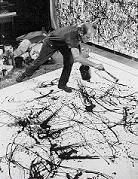Jackson Pollock (January 28, 1912 – August 11, 1956) was an influential American painter and a major force in the abstract expressionist movement. He died in a car accident near his home in Long Island, New York.Early life
The youngest of five sons, Pollock was born in Cody, Wyoming, and grew up in Arizona and California, studying at Los Angeles' Manual Arts High School. In 1930, following his brother Charles, he moved to New York City, where they both studied under Thomas Hart Benton at the Art Students League. Benton's influence on Pollock's formative work can be seen in his use of curvilinear undulating rhythms and in the use of rural American subject matter.Early work
Pollock's early representational work was influenced by Benton, and the Mexican Muralists Siqueiros and Orozco. He worked in Siqueiros's experimental workshop in New York City in 1936. After visiting exhibitions of Picasso and Surrealist Art, his work became increasingly symbolic. He worked on the WPA Federal Art Project from 1935 to 1943. Pollock's first solo show was held at the Peggy Guggenheim The Art of This Century Gallery in New York in 1943.Pollock had for several years been treated by psychiatrists for alcoholism and depression and this gave him an interest in Carl Jung's theory of primitive archetypes that formed the basis of his work between 1938 and 1944. These works were often enigmatic and were not well received at first.The Springs period and the unique technique
Pollock-Krasner house in Springs. It is now operated by State University of New York at Stony Brook with scheduled appointments to see his paint splattered studio.
Controversy swirls over the alleged sale of No. 5, 1948 in 2006 for a reported $140 millionIn October 1945 Pollock married his long term lover Lee Krasner and in November they moved to Springs on Long Island, New York. Their home in Springs was typical of the area, a wood-frame house with a nearby barn that Pollock made into a studio. It was there that he perfected the technique of working spontaneously with liquid paint. Pollock was introduced to the use of liquid paint in 1936, at an experimental workshop operated in New York City by the Mexican muralist David Alfaro Siqueiros. He later used paint pouring as one of several techniques in canvases of the early 1940s, such as "Male and Female" and "Composition with Pouring I." After his move to Springs, he began painting with his canvases laid out on the studio floor, and developed what was later called his "drip" technique, although "pouring" is a more accurate description of his method. He used hardened brushes, sticks and even basting syringes as paint applicators. Pollock's technique of pouring and dripping paint is thought to be one of the origins of the term action painting.In the process of making paintings in this way he moved away from figurative representation, and challenged the Western tradition of using easel and brush, as well as moving away from use only of the hand and wrist; as he used his whole body to paint. In 1956 Time magazine dubbed Pollock "Jack the Dripper" as a result of his unique painting style.“ My painting does not come from the easel. I prefer to tack the unstretched canvas to the hard wall or the floor. I need the resistance of a hard surface. On the floor I am more at ease. I feel nearer, more part of the painting, since this way I can walk around it, work from the four sides and literally be in the painting. â€
“ I continue to get further away from the usual painter's tools such as easel, palette, brushes, etc. I prefer sticks, trowels, knives and dripping fluid paint or a heavy impasto with sand, broken glass or other foreign matter added.
When I am in my painting, I'm not aware of what I'm doing. It is only after a sort of 'get acquainted' period that I see what I have been about. I have no fear of making changes, destroying the image, etc., because the painting has a life of its own. I try to let it come through. It is only when I lose contact with the painting that the result is a mess. Otherwise there is pure harmony, an easy give and take, and the painting comes out well.
â€Pollock observed Indian sandpainting demonstrations in the 1940s. Other influences on his pouring technique include the Mexican muralists and also Surrealist automatism. Pollock denied "the accident"; he usually had an idea of how he wanted a particular piece to appear. It was about the movement of his body, over which he had control, mixed with the viscous flow of paint, the force of gravity, and the way paint was absorbed into the canvas. The mix of the uncontrollable and the controllable. Flinging, dripping, pouring, spattering, he would energetically move around the canvas, almost as if in a dance, and would not stop until he saw what he wanted to see.
